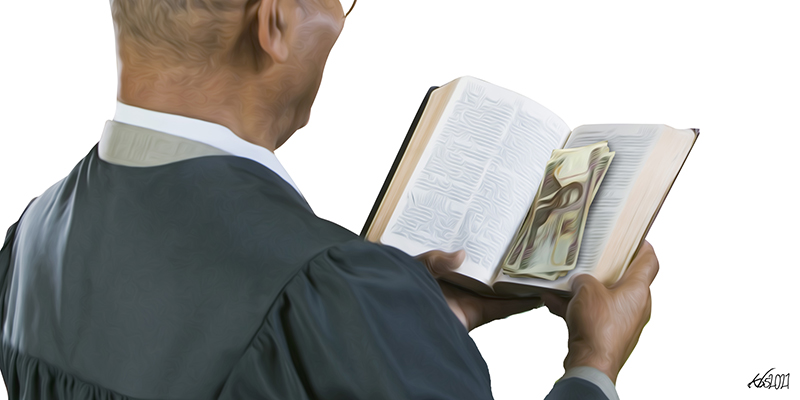There has been an ongoing debate in the last couple of months about the hefty cash donations politicians make to churches and to individual clergymen in Kenya. There have also been debates about the impact of money on the relationship between the church and the state, and about by the political class co-opting church leaders. There is even talk now about politicians radicalising thousands of angry, disenfranchised, jobless youth through cash donations and political and religious ideologies. An emerging Christian nationalism that is inspired by populist politics in many parts of the world also has many observers worried. Money, economic disenfranchisement and religious ideologies are blamed for this emerging trend.
A large section of Christian evangelicals in Africa, for example, support populist politicians including former President Donald J. Trump. In Kenya, money, ethnicity and religion have apparently taken centre stage in national politics in the last couple of years and this could lead to seriously compromising the religious leaders’ ability to stand up to the political class.
Deputy President William Ruto has caused a furore over the millions of shillings he has been donating to the churches. Ruto has sought to create an image of himself as a God-fearing generous giver, as demonstrated in the many churches he has visited, the questionable source of the money donated notwithstanding.
The clearest example of this is the dichotomy now playing between the president-led Kieleweke and Deputy President-led Tanga Tanga factions of the ruling Jubilee Party. When they took their battles to the African Independent Pentecostal Church of Africa (AIPCA) in Kenol area of Murang’a County on 4 October 2020, it led to the deaths of two young men. The commotion created at Gaitegi AIPCA church by the two opposing factions is the latest testament of how the church has been infiltrated by the dark forces of political rivalry.
On 11 January 2021, Bishop Margaret Wanjiru of Jesus is Alive Ministries (JIAM) was back in the limelight. A video circulating on social media showed the evangelist-turned-politician-turned-Ruto supporter dishing out money to scores of people.
While some church leaders in the Anglican and the Catholic churches have clearly told politicians to keep their money off their pulpits, the majority of Kenya’s clergy, especially those of the evangelical and the pentecostal persuasion — and particularly the prosperity gospel-allied churches — see absolutely nothing wrong with this. Anglican Church of Kenya (ACK) Archbishop Jackson Ole Sapit, while speaking in a multisectoral initiative against corruption in 2019, warned ACK clerics against accepting corrupt money. “Let us not allow Harambee money to become a subtle way to sanitise corrupt leaders,” said Sapit. Deputy President William Ruto and a coterie of politicians allied to him promptly answered Sapit: “We will continue to worship Jehovah God with our hearts and substance. We are unashamed of God and unapologetic about our faith.”
In Kenya, money, ethnicity and religion have apparently taken centre stage in national politics.
On 24 October 2020 Ruto held a fund-raising meeting for the St Leo Catholic Church in Sianda, Mumias East. Evidently, the COVID-19 crisis and the lockdown had not locked up the DP’s purse. Clearly, it’s not only the evangelical leadership that covets politicians’ money. While the Anglican and Catholic churches’ leadership have clearly specified their criteria for receiving donations, and have at the same time asked the politicians to keep off their pulpit and keep their money, evangelical and pentecostal churches, especially those aligned to the prosperity gospel, see nothing wrong with accepting money from politicians. There have been public spats and bitter exchanges in the country that essentially encapsulate a debate that has not only refused to go away, but one that divides Christians and non-Christians alike.
The Kenyan Church and its credibility
Struggling with a legitimacy crisis since the 2007/8 post-election violence (PEV), the church leadership seems to have abandoned its flock, divided by ethnicity and politics as it is. Archbishop David Gitari (ACK), Archbishop Raphael Ndingi Mwana a’Nzeki of the Catholic Church and retired Rev. Timothy Njoya of the Presbyterian Church of East Africa (PCEA) fought for democracy, freedom of expression and multiparty politics during Daniel T. arap Moi’s dictatorial reign and have often been described as the architects of social justice and as the conscience of the nation.
The emergence of evangelical pastors driven by the gospel of prosperity seems to have undone all the foundational work that these mainstream church leaders fought so hard to set up. The PEV exposed the underbelly of the Kenyan church as it were and since then, the church has never been the same and it has struggled to recover its image as the moral compass of the nation. The National Christian Council of Kenya (NCCK), the umbrella body that brings together all the protestant churches, even offered a public apology, acknowledging that the Church had let down Kenyans.
Given the fact that liberal democracy thrives where the secular and religious domains keep a safe distance from each other, the churches’ acceptance of hefty cash donations from politicians has led Kenyans to question the very credibility and legitimacy of these churches’ leadership. Yet the co-option of religious leaders by the state and politicians is nothing new. The Deputy President’s donations to churches have brought to the fore the causal inter-play between church and state, the intersection between faith, politics and governance issues. The donations have also raised critical questions about the relationship between Christianity and religio-ethnic politics.
Christianity and religio-ethnic politics
Religio-ethnic political competition and mobilisation have increasingly become the defining features of electoral politics in Africa, Kenya included. In Kenya, God, politics, money and ethnicity are often inseparable. Yet church politics, money and ethnicity have recently assumed centre stage. During the 2013 and 2017 general elections, for example, political competition was increasingly defined and characterised by the use of the notions of God and tribe. The appropriation of biblical language and rhetoric and its imagery by politicians during the campaign periods sought to paint their politics as God-driven and God-ordained, while casting their antagonists’ politics as driven by the dark, evil forces of Satan and witchcraft.
Prior to the 2013 general elections, the Jubilee Coalition presidential candidate and his running mate, Uhuru Kenyatta and William Ruto, faced criminal charges at the International Criminal Court (ICC). To fend off the ICC, the duo turned to religious rhetoric and portrayed their tribulations as the work of the devil and the opposition, then led by Raila Odinga. They also referred to the civil society as the “evil society.” Uhuru and Ruto traversed the country, holding political rallies camouflaged as prayer meetings, accompanied by a retinue of clergymen who would lay hands on them and anoint them with special oil, as they prayed fervently, casting away ICC demons, castigating the opposition and condemning the “evil society”.
Their political nemesis, Raila Odinga of the National Super Alliance (NASA), equally appropriated religious rhetoric. Raila promised to lead Kenyans to a new dawn by taking them to Canaan, the Promised Land that flows with milk and honey. He appropriated the biblical imagery of the Book of Exodus, where he likened himself to Joshua, who would lead the people out of slavery into the “promised land”. The imagery became a rallying call for millions of his followers. In 2019 and 2020, Deputy President Ruto not only appropriated Christian theological language, but also became one of the biggest church funders just like President Moi before him.
In a bid to outdo everyone, Ruto has elevated the prosperity gospel and its proponents, the self-styled prophets and bishops, to unprecedented levels of self-importance. In the process, he has cleverly cultivated a Christian nationalistic image, subtly appropriating pentecostal language in his public speeches. He has also been accused of taking advantage of the socio-economic vulnerabilities of unemployed youth in a way that could potentially radicalise them.
Ruto’s cosy relationship with the clergy should be understood in the light of religio-political and ethnic mobilisation that has now become the defining feature of post neo-liberal politics in Kenya and beyond. During the 2010 constitutional referendum, Ruto aligned himself with the Christian clergy to oppose the new constitution. Since then, the relationship between the Deputy President and the Christian right in Kenya has blossomed, the allegations of corruption made against him notwithstanding; Ruto has his allies in the church.
Liberal democracy thrives where the secular and religious domains keep a safe distance from each other.
In a country reeling from massive debt, loss of employment and the coronavirus pandemic, the clergy has been silent as Kenyans go through unprecedented suffering, massive job losses, a weak public health infrastructure, corruption, and the theft of medical equipment donated by humanitarian people and organisations. Their loud silence in the wake of the high numbers of deaths of medical personnel, the doctors’ strike and the controversial BBI politics, has been deafening.
But Ruto’s disturbing relationship with the clergy is not anything new. Moi heavily appropriated religion and created for himself an image of a God-fearing politician who not only attended church service ritually and piously every Sunday, but who also heavily invested in the churches and the clergy by contributing large amounts of money and allocating them large tracts of land.
Politicians have perfected the art of appropriating religion in times of crises. With the onset of the coronavirus pandemic, politicians have been calling on religious leaders to offer prayers as they call on the people to repent their sins. While there is nothing wrong with politicians asking for frequent and collective prayers when the country is faced with crises, Kenyans also need to question how they are governed and what the priorities of their politicians should be. No amount of prayers will ever take away bad governance, corruption, disease, inequality, poverty, road accidents and violence. These are policy issues that have everything to do with ethical and just leadership, the rule of the law, governance of national resources, respect for human rights, well-equipped and functional hospitals and efficient public service delivery, and little to do with religion.
Deputy President Ruto’s relationship with the clergy must be understood through the prism of, not just the politicisation of religion, but also its implications for good governance, and for the church and the state. The Jubilee Party administration has since 2013 been weakening the church’s leadership by compromising it with money so that the clergy does not call out on its excesses.
In Kenya, the church and the state have always had a symbiotic relationship. The clergy has always tried to co-opt political leaders while the state has always been involved in schemes to co-opt the church. This is not to ignore the fact that the leaders of certain mainstream churches have, in certain critical political moments, stood their ground and urged the government to abandon its authoritarian tendencies, and even pushed for constitutional reforms.
After the promulgation of the new Constitution of Kenya 2010, mainstream churches took a back seat as pentecostal and evangelical churches occupied the centre stage of the country’s political arena. Ruto has ostensibly found dependable allies in the majority of evangelical churches, who see him as a generous giver and one who fits in well with their health-and-wealth gospel.
This is not peculiar to Ruto. Politicians across the country continue to appropriate religious idioms, language, rhetoric and symbolisms. We are witnessing the same developments in other African countries like Ethiopia, Ghana, Malawi, Nigeria, Tanzania and Uganda — politicians appropriating religion as a means to their political ends. In 2016, Donald Trump appealed to the evangelical right and their unwavering support helped him win his presidential bid. In 2020 Trump again appealed to the same Christian right to try to win a second term. He appropriated religion and mobilised the evangelical right to cast himself as the protector of religious rights from neo-liberals, socialists and leftists.
The Ruto factor in churches and its implications for governance
William Ruto projects the image of a God-fearing man under perpetual siege from the political dark forces of Satan. He gives the impression that his Christian faith has helped him overcome the forces that his political enemies are using to fight him. While his enemies are busy working hard to make him look bad in the eyes of the electorate, the church, it seems to me, has also been working overtime to paint him in the light of a generous servant of God who is largely misunderstood. Even as his enemies describe him as a most corrupt, divisive and ambitious politician, the church makes him look humble and decent and “a fearfully made child of God” who is a victim of political machinations.
Ruto’s spirited efforts to be allied with the clergy must be understood within the context of a search for a Christian legitimacy and social respectability. The Deputy President could also be looking for approval and acceptance from the clergy. He is looking to his faith to repair a badly damaged public image that has refused to go away: the image of a fabulously wealthy politician who passes himself off as a humble servant of God who speaks the language of the downtrodden. And so the apparent association with the church is a quest to portray himself as a victim of dynastic politics that are jealous of his “hustler” beginnings and that do not want him excelling in national politics. In short, Ruto is using the church to advance his overarching political ambitions.
Like many a politician before him, Ruto has appropriated religion during this period of turmoil in his political career to draw, not just admiration, legitimacy and respect, but also empathy and pity. The late President Moi appropriated the Christian faith to cleanse his autocratic regime. Zambia’s President Fredrick Chiluba declared himself a Christian and Zambia a Christian nation, despite the massive corruption dogging his country. The recently deceased President John Magufuli declared that God had healed Tanzania of the COVID-19 pandemic. He appropriated religion and notions of God in his populist politics in a way that appealed to millions of religious people wish want to see God at the centre of politics and governance.
Intent on getting money and socio-political power to influence public policy, the Church has opened itself to the vagaries of political pedlars. To that extent, hunger for power, particularly political and social power play, is no longer the preserve of politicians. The Kenyan clergy also wants a piece of that power and influence. Hence, spiritual power is hardly the driving force of these religious leaders who no longer view politics as a dirty game. On the contrary, many clergy now see politics as a means to financial, social and political power. African pentecostal and evangelical clergy (with the exception of a few who are well-grounded in proper theological training) lack the philosophical and theological tools to engage the state or politicians. Many rely on the Holy Spirit to interpret scripture and socio-political phenomena. Pentecostal clergy are also prone to populist politics and, more importantly, they are less likely to criticise a dictatorial government. They prefer to pray away issues including pandemics like COVID-19. They are beholden to faith healing, miracles and the gospel of prosperity. Human rights, social justice and poverty are not issues they like to engage with, let alone seek to understand their primary causes; they much prefer spiritualising issues.
The church leadership of the pentecostal and evangelical churches believes in creating social transformation by transforming individuals’ morals and personal lives, which is commendable. Individual transformation is not necessarily a bad thing, but it would be even better if the whole society were to be fundamentally transformed. Pentecostals also place greater emphasis on the heavenly realm and the hereafter than in the hell in which many Kenyans already live. In a country under bad governance, the theology of individual transformation must be questioned. And we must ask critical the questions: how is it that a highly religious country like Kenya, where more than 80 per cent of the population identify as Christians, has not seen it fit to embrace meaningful socio-political transformation?
Religion “cleans” up people, gives them a veneer of credibility, respect and acceptance. That is why politicians align themselves with the Church. When politicians are under siege, they take refuge in the Church, even as they seek to mobilise their ethnic bases. In a kind of symbiotic relationship, religious leaders use politicians such as Ruto to access state resources and political power. In return, politicians give the clergy not just money, but personal appeal, social power and a sense of self-importance. Such clergy crave to be seen as special “big men and women of God” who are powerful, rich and have friends in high society. One would hope that spiritual leaders would be the salt of the earth, that they would champion social justice causes as well as human flourishing, but unfortunately, like the political class, they seek power, prestige, money and state recognition for their own sake.
There are a myriad other reasons why the clergy courts politicians. In its effort to push its conservative agenda on reproductive health and rights, sex education, sexuality and gender empowerment among many other issues, the clergy’s romance with the political class is strategic: they are partners when it comes to controlling society for their own selfish ends. Kenyans have not forgotten that religious leaders coalesced around Ruto to oppose the adoption of the 2010 constitution; he clergyviewed the constitution as too liberal in matters of sexuality, reproductive health rights and women’s place in society.
There has also been religious mobilisation and contestation over sexual and reproductive health rights and choices in Kenya, as recently witnessed with the Reproductive Health Bill (2019) and during the 2019 UN Conference on Population and Development (ICPD25) held in Nairobi. On the two occasions, religious leaders and their powerful lobbies employed mobilisation tactics to oppose the Reproductive Bill and the ICPD25 conference. Demonstrations were recently held against the Reproductive Health Bill — also christened the abortion bill or the Susan Kihika bill — because of its supposedly neo-liberal agenda.
Kenyans have not forgotten that religious leaders coalesced around Ruto to oppose the adoption of the 2010 constitution.
The influence of the American evangelical far right is also evident in Kenya’s conservative churches, especially in the area of sexuality and reproductive health rights. The American evangelicals’ support for President Donald J Trump — who is not a Christian by any standards but uses Christianity for his own political ends — is alive in African evangelical circles. Some of the evangelical pastors here in Kenya are reported to have prayed for Trump as he battled to win a second term in the 4 November 2020 elections. One of the reasons evangelicals support Trump is because he aligns himself with the Christian right’s ideologies and conservative positions on a score of social and political issues.
It is also a fact that evangelical churches here in Kenya receive a lot of funding from the American evangelical right. The same logic explains the clergy’s relationship with politicians in Kenya. It is a money thing. And it is not hard to see. In its 10th month now, the COVID-19 pandemic has left many Kenyans vulnerable and in dire need of financial help. Yet the Church leadership has chosen to pursue its narrow agenda of cavorting with the political class in exchange for financial gain, self-aggrandisement and the opportunity to influence public policy.
A dozen years after PEV, the church leadership in Kenya does not seem to have learnt any lessons. It has become the butt of crude jokes on social media from a woke generation that does not fear and is not beholden to the “touch not my anointed servants” cliché. It has refused to be spiritually blackmailed and financially manipulated. That generation is daily debunking the myth of spiritual power and torment.
Religious institutions and religious leaders are important actors, key elements and important forces within civil society. Religion is also important in the lives of many Africans, Kenyan’s in particular. A recent Pew Research Poll found that more than 85 per cent of Kenyans said religion was very important to them. There are a number of reasons why religion is important to Kenyans. First, religion provides Kenyans with the language to make sense of their suffering. Secondly, religious people want to see good people voted into government because they believe they can bring ethical leadership and decency to public life. Christians want to see good people voted in, people who promote healing, national cohesion and economic betterment.
The Church has become the butt of crude jokes on social media from a woke generation that does not fear and is not beholden to the “touch not my anointed servants” cliché.
But this is not the case. Instead what we have is a clergy that is in bed with the political class. Co-option of the clergy is bad for democracy and governance. When the Church and its clergy accept monetary contributions from politicians, it compromises them. The Church loses its voice, conscience and ability to hold politicians and the state accountable. In a country reeling from corruption, bad governance, gender and sexual abuse, high incidences of teenage pregnancy, police violence, poverty, ethnic marginalisation, inequality, ethnic tensions and the coronavirus pandemic, Kenya needs a clergy that can boldly speak up against the state and hold political leaders accountable even as they set a good example of moral leadership themselves. Kenya needs a new moral compass and consciousness, an alternative imagination from both citizens and religious leaders. But such leaders in Kenya today are few and far between; partisan politics always has its consequences, more so for the church leadership.
The Ruto factor in church can therefore be understood as a weakening of the structure of the church and the co-option of its leadership. Yet, it also speaks of the church’s lack of philosophical and theological tools to deal with such infiltration, a lack of ethical and moral underpinning to resist such an injudicious relationship. Yet I proffer that it is not too late for religious leaders to rethink their nebulous association with the political class and to re-engage the Kenyan people in their quest for social justice and human flourishing.








